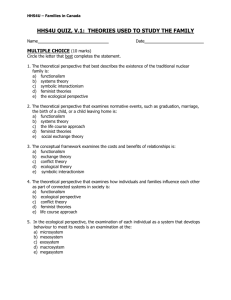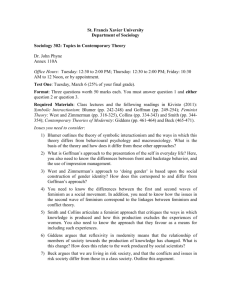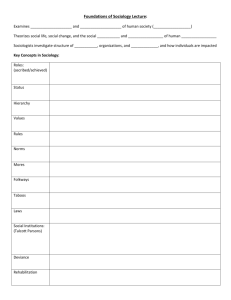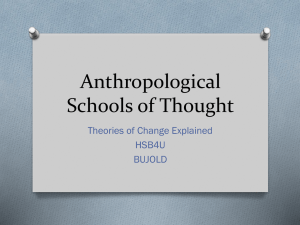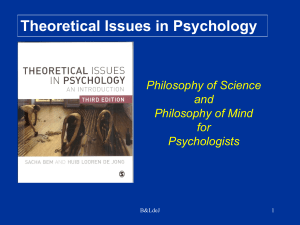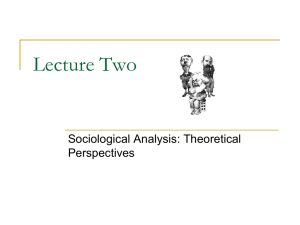UNIT 2: Culture
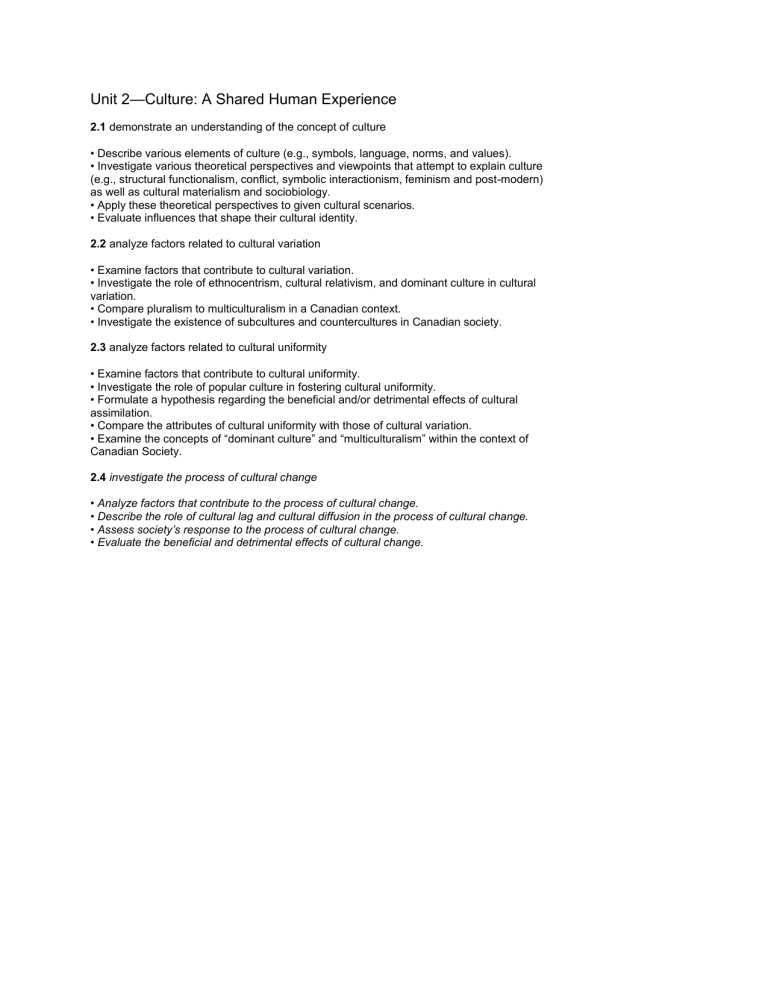
Unit 2
—Culture: A Shared Human Experience
2.1 demonstrate an understanding of the concept of culture
• Describe various elements of culture (e.g., symbols, language, norms, and values).
• Investigate various theoretical perspectives and viewpoints that attempt to explain culture
(e.g., structural functionalism, conflict, symbolic interactionism, feminism and post-modern) as well as cultural materialism and sociobiology.
• Apply these theoretical perspectives to given cultural scenarios.
• Evaluate influences that shape their cultural identity.
2.2 analyze factors related to cultural variation
• Examine factors that contribute to cultural variation.
• Investigate the role of ethnocentrism, cultural relativism, and dominant culture in cultural variation.
• Compare pluralism to multiculturalism in a Canadian context.
• Investigate the existence of subcultures and countercultures in Canadian society.
2.3 analyze factors related to cultural uniformity
• Examine factors that contribute to cultural uniformity.
• Investigate the role of popular culture in fostering cultural uniformity.
• Formulate a hypothesis regarding the beneficial and/or detrimental effects of cultural assimilation.
• Compare the attributes of cultural uniformity with those of cultural variation.
• Examine the concepts of “dominant culture” and “multiculturalism” within the context of
Canadian Society.
2.4 investigate the process of cultural change
• Analyze factors that contribute to the process of cultural change.
•
Describe the role of cultural lag and cultural diffusion in the process of cultural change.
• Assess society’s response to the process of cultural change.
•
Evaluate the beneficial and detrimental effects of cultural change.
Lesson 1: What is culture
Outcomes:
2.1 demonstrate an understanding of the concept of culture
• Describe various elements of culture (e.g., symbols, language, norms, and values).
• Investigate various theoretical perspectives and viewpoints that attempt to explain culture
(e.g., structural functionalism, conflict, symbolic interactionism, feminism and post-modern) as well as cultural materialism and sociobiology.
• Apply these theoretical perspectives to given cultural scenarios.
• Evaluate influences that shape their cultural identity.
Materials:
Definitions of culture
LCD
Overhead of Tower of Culture
I am From (Student Blank, & Overhead)
Lesson:
Give pairs of students slips of paper with various definitions of culture. Ask students to “divide” their desks into two coloumns. In the one on the left they will put what they think are definitions of culture. In the right they will put what they think are not culture. Get answers from the class about what they think is and is not culture. The funny answer – they are all definitions of culture.
Ask students why they think there are so many definitions of the word. Ask students what does the word mean?
Show what is culture - http://www.youtube.com/watch?v=ai9pRv_t3y8
Give working definition of culture and ask students to copy:
Culture is the combined thoughts, attitudes, and beliefs of a group of people who tend to live in the same geographic area. Culture is expressed through a variety of methods including dress, language, religion, and food.
Cultural expression tower – put up overhead of cultural expression tower and explain to students that culture is how we think and cultural expression is the outward view of what we think the cultural expression tower is the representation of the key pieces of who we are. The elements of a cultural tower include: religion, dress, music, language, food, articheture
Cultural expression tower from them
(IF TIME) “I am from poem” is another way of showing culture – show them the I am from poem and complete on the overhead based on me
I am from poem ask them to complete
Lesson 2: Cultural Scenearios
Outcomes:
• Investigate various theoretical perspectives and viewpoints that attempt to explain culture
(e.g., structural functionalism, conflict, symbolic interactionism, feminism and postmodern) as well as cultural materialism and sociobiology.
• Apply these theoretical perspectives to given cultural scenarios.
Materials:
LCD
Computer with Internet access hrsbstaff.ednet.ns.ca/jwelcher
Lesson:
Start class without saying anything simply play the HAKA Dance
( http://www.youtube.com/watch?v=c-lrE2JcO44 ) Haka then play the All Blacks completing the
HAKA ( http://www.youtube.com/watch?v=uHW1K2LeQXE&feature=related )
Ask students why I did this – What did I want them to see. Guide to similiarities to what the
HAKA dance is and the intent of the dance used by the All blacks. Eventually give them that the
All Blacks used a culturally important tradition and morphed it to their context. The tradition of the HAKA dance now belongs to more than one culture and means more than one thing. This is a danger in examining culture. If you do not know about the context of a specific tradition you risk making judgements about the culture that may or may not be true.
Write the terms structural functionalism, conflict, symbolic interactionism, feminism and post-modern on the overhead. Review with students the meanings of these words.
Write Cultural Materialism and socio-biology on the overhead. Ask students what they feel these words are. Write down the actual meaning and ask students to copy.
Cultural Materialism: Human social life is a response to the needs of survival and then the wants of people who have met those needs. Therefore, human cultural groups can be studied through an examination of their “ things” and how they get them.
Sociobiology: Human behaviour can be explained through evolution and genetics.
Give students catalogue sheet. Inform students that I will play various clips relating to culture and it is their job to catalogue them into one of the 6 categories of cultural perspective. (functionalism, conflict, symbolic interactionism, feminism, post-modern, cultural materialism, socio-biology)
Play the films and after each one give the students a few minutes to decide their category. Allow limited discussion at the end of each one but not discussion that would give away their perspective.
At the end of the exercise review student answers then show the students the answers.
1. Cultural Materialism Coke Commercial http://www.youtube.com/watch?v=IzxHDqUz8Sk
2. Structural Functionalism Japanese Divorce ceremony http://www.cnn.com/video/#/video/living/2010/09/06/lah.japan.divorce.ceremony.cnn
?hpt=T2
3. Feminism/ Symbolic Interactionalism Suri Lip Plates http://vimeo.com/6177244
4. Feminism Female Circumcision http://www.youtube.com/watch?v=9kNMC65pNsg
5. Post modern Quiet Kid Learns to Cope in Prison http://www.youtube.com/watch?v=PAS4uSDJe9k&feature=related
6.
Socio-biology The Sports Fan http://www.youtube.com/watch?v=zs-fiae1VT
Determining Cultural Perspective (Formative)
Outcomes:
• Investigate various theoretical perspectives and viewpoints that attempt to explain culture (e.g., structural functionalism, conflict, symbolic interactionism, feminism and post-modern) as well as cultural materialism and socio-biology
• Apply these theoretical perspectives to given cultural scenarios.
The examples of culture reviewed as a class are all listed on this sheet. For each one decide the cultural perspective then determine why they belong to this perspective.
Category/Perspective of
Culture
Cultural Materialism
Example of Culture
Coke Commercial
Reasoning
Structural Functionalism Japanese Divorce ceremony
Suri Lip Plates Feminism/ Symbolic
Interactionalism
Feminism Female Circumcision
Post modern Quiet Kid Learns to Cope in Prison
The Sports Fan Socio-biology
Determining Cultural Perspective (Formative)
Outcomes:
• Investigate various theoretical perspectives and viewpoints that attempt to explain culture (e.g., structural functionalism, conflict, symbolic interactionism, feminism and post-modern) as well as cultural materialism and socio-biology
• Apply these theoretical perspectives to given cultural scenarios.
The examples of culture reviewed as a class are all listed on this sheet. For each one decide the cultural perspective then determine why they belong to this perspective.
Example of Culture Reasoning Category/Perspective of
Culture
Lesson 3: The Big Apple
Outcomes:
2.1 demonstrate an understanding of the concept of culture
• Describe various elements of culture (e.g., symbols, language, norms, and values).
• Investigate various theoretical perspectives and viewpoints that attempt to explain culture
(e.g., structural functionalism, conflict, symbolic interactionism, feminism and post-modern) as well as cultural materialism and sociobiology.
• Apply these theoretical perspectives to given cultural scenarios.
• Evaluate influences that shape their cultural identity.
Materials:
Library access
Summative Assessment for all students (Available on website hrsbstaff.ednet.ns.ca/jwelcher/sociology12 as Culture summative assessment 1)
Lesson:
Run this lesson as a summative assessment. Book the computer lab/library and give the students this class to work on it.
The links below are included on the assessment with the concept they exemplify beside them: http://nymag.com/ (Cultural Materialism) http://www.nytimes.com/2010/09/12/world/europe/12raids.html?_r=1&hp (post modern) http://www.nytimes.com/2010/09/12/business/12suit.html?hp
(symbolic interactionalist) http://www.nytimes.com/2010/09/12/us/12shelter.html?hp
( structural functionalism ) http://www.nytimes.com/2010/09/12/us/12westlake.html?ref=us (Conflict) http://topics.nytimes.com/top/news/us/series/women_at_arms/index.html?ref=us (Feminist) http://www.nytimes.com/2010/09/12/realestate/12cov.html?hp
(Sociobiology)
Culture Summative Assessment 1
2.1 demonstrate an understanding of the concept of culture
Outcome Indicators of Mastery
• Describe various elements of culture (e.g., symbols, language, norms, and values).
• Investigate various theoretical perspectives and viewpoints that attempt to explain culture
(e.g., structural functionalism, conflict, symbolic interactionism, feminism and post-modern) as well as cultural materialism and sociobiology.
• Evaluate influences that shape their cultural identity.
• Apply these theoretical perspectives to given cultural scenarios.
Assessment:
Through this assessment you will analyze various examples of culture but before you can do that you have to analyze your own.
Reflecting on your culture:
Question
How do you express your culture? (Think back to your cultural expression tower).
Research resources http://www.buzzle.com/articles/cha racteristics-of-culture.html
What would happen if you moved to a place where you had never been? Everything about the culture of the people you meet is different – different languages, different foods, different religions, different music, different clothing – how could you adapt? http://www.ehow.com/how_21839
57_adjust-new-culture.html
http://moving.about.com/od/intern ationalmoves/a/culture_shock.htm
http://www.theparentreport.com/r esources/ages/teen/kids_culture/32
3.html
/5
Question
Think about typical western/North American culture. You are provided with links (one for each of the perspectives of culture by sociologists and anthropologists). Follow those links and decide which of the following perspectives they match and why they match them.
Research resources
1.
http://nymag.com/
2.
http://www.nytimes.com/2010/09/12/world/e urope/12raids.html?_r=1&hp
3.
http://www.nytimes.com/2010/09/12/busines s/12suit.html?hp
4.
http://www.nytimes.com/2010/09/12/us/12sh elter.html?hp
5.
http://www.nytimes.com/2010/09/12/us/12w estlake.html?ref=us
6.
http://topics.nytimes.com/top/news/us/series/ women_at_arms/index.html?ref=us
7.
http://www.nytimes.com/2010/09/12/realesta te/12cov.html?hp
Decide if you would recommend western culture to others who are culture shopping.
Then either recommend western culture or not. This recommendation can take any form you wish – written, PPT movie or artistic.
Lesson 4: Difference
Outcomes:
2.3 analyze factors related to cultural uniformity
• Examine factors that contribute to cultural uniformity.
• Investigate the role of popular culture in fostering cultural uniformity.
• Formulate a hypothesis regarding the beneficial and/or detrimental effects of cultural assimilation.
• Compare the attributes of cultural uniformity with those of cultural variation.
• Examine the concepts of “dominant culture” and “multiculturalism” within the context of Canadian Society.
Materials: https://www.schoolofhope.org/guest/senior/social_studies/10-4/Multicultural-Act.pdf
(primer on the multiculturalism act 1988)
Overhead
Lesson:
Ask students to define conformity. Once we get a good working definition of conformity ask if it is a good thing. Get discussion going that is both pro-and con.
Ask students to copy the following definition: Cultural Conformity: Pressure on a minority group to adopt the same cultural expressions as a majority group.
On an overhead divide the sheet in two. On one side write the benefits of conformity and on the other write the cons to conformity. Ask students if they know that Canada actually has a policy of cultural variation. Ask students if they know the official name of this policy.
Review Multiculturalism act (PDF Primer) with students. What do they see happening in society?
What about in school? Are we doing enough?
Brainstorm with students lists of what we do as a school to honour the Act.
Break students into groups of 4. Have students create a wish list of three different ideas they could do to promote multiculturalism within the school. Ask them to keep their ideas realistic – they have to be achievable and they have to be cheap. Discuss their ideas.
Lesson 5: Cultural relativism v. Ethnocentrism
Outcomes:
2.2 analyze factors related to cultural variation
• Examine factors that contribute to cultural variation.
• Investigate the role of ethnocentrism, cultural relativism, and dominant culture in cultural variation.
• Compare pluralism to multiculturalism in a Canadian context.
• Investigate the existence of subcultures and countercultures in Canadian society.
Materials:
Library Access (School Library or computer lab)
Student Handout Cultural Exploration
Lesson:
Ask students what is good
– what is a good action? Discuss the merits of good actions. Ask students about difference – is difference good or bad?
Write the words ethnocentric and cultural relativism on the overhead. Ask students if they know those terms.
Get students to copy the following definitions:
Ethnocentric – The belief that a group’s own cultural group is superior to all others and that difference is somehow lesser.
Cultural Relativism – The belief that truth, right, and wrong are all in context to your cultural group and that no one culture is above or greater than another.
How does the debate between cultural relativism and ethnocentrism play out in Canada? What do we do?
Do we do it well? How do we tend to react when a person is not of the same culture as the dominant?
Give students the assessment sheet and go to the library.
Cultural Exploration
Outcome
• Investigate the role of ethnocentrism, cultural relativism, and dominant culture in cultural variation.
• Compare pluralism to multiculturalism in a
Canadian context.
Indicators of Mastery
Summative Assessment:
/5
Pick any 2 of these statements or questions and reflect. Your reflection may be visual, academic formatted, informal written, or as a film or digital photo essay. However, once you have chosen a format you may not choose it again. Your only requirement is to give credit to other people for their work and use a citation system and a bibliography. Your independent study requires
APA so you could try it out now.
1.
Ethnocentrism is a reason for violence across the globe. Find at least two different examples of ethnic violence and explain what happened and how they are examples of ethnocentrism. Can ethnic violence be stopped?
2.
Canada has a policy of multiculturalism. Does this policy meet reality?
3.
Cultural relativism is seen as dangerous to some religious and racial groups. Why?
4.
What does a potential immigrant have to do to move to Canada? Is this process streamlined and easy or drawn-out and difficult? When you think of this process think of it as a person who does not speak or read English or French and that you need help to understand what you are reading.
Research Resources:
Some of the links provided will take you to biased viewpoints which some would loosely call research. Please consider that when viewing these sites that nothing will get people more charged than culture or religion and that this will express itself in their communication (ie. Blogs, websites...)
Research Links http://www.cultural-relativism.com/ http://www.cic.gc.ca/english/index.asp
http://en.wikipedia.org/wiki/Cultural_relativism http://www.gotquestions.org/cultural-relativism.html
http://www.munfw.org/archive/50th/4th1.htm
http://www.antiwar.com/hacohen/h011303.html
http://www.voanews.com/english/news/asia/Scale-of-Ethnic-Violence-in-Kyrgyzstan-
Remains-Mystery-96414124.html
http://www.thestar.com/News/article/218666
Possible search terms
Ethnic violence, ethnic cleansing, racism, multicultural, cultural relativism, religion and culture
